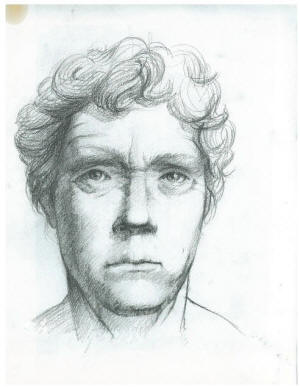|
Special Report: In 2014, a woman’s
severed head was found. Who is she?
 Send a link to a friend
Send a link to a friend
 [November 02, 2017]
By Blake Morrison and Nicholas Bogel-Burroughs [November 02, 2017]
By Blake Morrison and Nicholas Bogel-Burroughs
ECONOMY, Pennsylvania (Reuters) - The
woman’s severed head lay in the woods, 10 yards off a rural road. Her
mouth was open. Her eyes were closed. Her hair was gray and fluffy.
A teenager spotted her about half past noon on Dec. 12, 2014. Moments
later, police say, the boy called 911. “I found a human head,” he calmly
told the operator.
Today, almost three years after the discovery, the woman’s identity
remains a mystery.
Authorities haven’t determined how or when she died, her age, why she
was decapitated, or how her head came to rest off Mason Road in this
town of 12,000 not far from Pittsburgh.
Despite an initial flurry of tips, police say they have no suspects. But
they do have a leading theory.
They believe the head may have been severed by a so-called body broker –
someone who sells body parts from a cadaver donated to science.
“She was dismembered professionally,” said Michelle Vitali, an anatomy
professor at Edinboro University near Erie who closely examined the
head. “It’s part of the body parts trade.”
Pathologist Cyril Wecht, a veteran of more than 20,000 autopsies, agreed
that the cutting wasn’t done by an amateur. “We see a rather neat
surgical dissection,” Wecht said after examining crime scene photos.
“Somebody took their time.”

One reason the head may have come from the body trade: The industry has
been linked to similar abuses in the past.
Reuters has identified thousands of body parts that have been misused or
desecrated since 2004. In the case of Detroit-based body broker Arthur
Rathburn, authorities allege he “stored human heads by stacking them
directly on top of each other without any protective barrier.” Rathburn
faces trial in January, charged with defrauding health care clients by
misleading them about infected human remains and with lying to federal
agents.
Typically, however, authorities stumble across these cases only by
happenstance. An airline employee in Arkansas discovered 40 severed
heads being shipped in plastic containers in 2010. Two years ago in
Texas, police found an entire cadaver lying by the side of the road. It
had fallen from a van on the way to a body broker in Colorado. The
driver, Reuters reported at the time, hadn’t noticed that the body was
missing.
“HARD TO TRACK”
Complicating the Pennsylvania case: Bodies and parts can be bought, sold
and leased across America with relative ease. That makes determining the
origins of remains like the head found in Economy difficult if not
impossible.
“There’s so many places where you can get these parts,” Vitali said.
“But it’s hard to trace back.”
Police say they’ll likely need the public’s help to solve what they call
the most bizarre case they’ve handled.
“Two and half years plugging away at this thing. Got nowhere. It drives
me crazy,” said Andrew Gall, chief of detectives for the Beaver County
district attorney’s office. “I’ve been doing this job for a long time. I
hadn’t had anything where I had a body part like this turn up.”

In the days after the head was found, authorities used cadaver dogs to
scour the area. They also sought DNA from the woman, whose head had been
embalmed. But those efforts yielded nothing. They uncovered no evidence
in the forest, and the remains held no DNA; it had been destroyed by the
embalming chemicals, authorities say.
Police brought in Vitali, who is also a forensic artist, and released a
sketch and clay model she created to show what the woman may have looked
like alive. Investigators set up a telephone hotline and initially
figured a grave robber might be to blame. “I felt that we put this out
and any moment, the phone was going to ring with that information,” Gall
said. “That call never came.”
Quickly, the case of the bodiless woman, whom they now call Jane Doe,
went cold. And the remaining clues seemed bewildering.
RED RUBBER BALLS
At the local morgue, authorities found eye caps – a mortician’s tool to
keep the lids closed – in each of her eyes. But beneath those eye caps
lay a surprise: a small red rubber ball in each of Jane Doe’s otherwise
empty sockets.
The balls continue to baffle investigators and mortuary experts, who say
they have never heard of red rubber balls being used to replace removed
eyes. At least one company makes spheres that double as eye caps, but
they are vastly different in color and texture than the balls found in
the woman’s sockets.
Her eyes may have been taken through organ donation. But if Jane Doe
died recently, it is likely that “an eye bank or an organ procurement
organization would only remove the cornea from an eye,” said Wes Culp,
deputy press secretary for the Pennsylvania Department of Health.
A body broker, on the other hand, might remove and sell the full eye for
research purposes. Laws governing organ donation and the body broker
business differ substantially.
Transplantation organizations are strictly regulated but body brokers
are not.
But why fill the empty sockets with the red balls? Using cotton to fill
the space is cheaper. Red rubber balls, these marked CHINA, “are not
used in either the funeral profession or in organ donor networks,” said
Kevin Moran, an embalming instructor at the American Academy McAllister
Institute of Funeral Service in New York.

“In my 40 years of doing this, I have never seen that,” he said.
The use of caps in Jane Doe’s eye sockets was “very professional,” Moran
said. “And yet part of it is the rubber balls you get with a
ball-and-jacks set. It doesn’t make sense.”
The situation also perplexes detective Gall, who hasn’t ruled out
another scenario. “Prove to me it’s not a homicide – that she was alive
and someone killed her and played with that body,” he said, “including
putting the red eyeballs in there.”
“PATCHWORK DENTISTRY”
If anyone is likely to identify Jane Doe, it might be a dentist.
Authorities found a full set of teeth inside the woman’s mouth and took
X-rays. Dentists at the University at Buffalo School of Dental Medicine
examined the head and determined that work had been done on every single
tooth – one of them as many as seven times.
Using one of three teeth they pulled, the dentists also found what they
believe to be a filling compound that wasn’t available to dentists
before 2004, meaning the woman likely died sometime thereafter. Based on
their examination, dentists Raymond Miller and Peter Bush were able to
posit a possible profile of Jane Doe: a lower-income woman who had many
cavities and may have grown up where the water wasn’t fluoridated.

She probably lacked top-notch dental insurance that would have covered
crowns, but may have had a cheaper plan that paid for fillings, Miller
said. The work on her mouth was what Miller called “patchwork
dentistry,” in which problems are addressed only when necessary. Still,
the work was well done, both dentists agreed.
[to top of second column] |

An undated handout forensic artist sketch obtained by Reuters
October 19, 2017 shows what the woman whose head was found in
Economy Borough, Pennsylvania, U.S. in 2014 may have looked like
when she was alive. Courtesy Michelle Vitali/Economy Borough Police
Department/Handout via REUTERS

“Somebody took good care of her,” Miller said. “Every tooth is
filled or fixed in her mouth.” The extent of that work would make
her “an easy ID if we had any kind of information about her.”
“VERY PRECISE” CUT
Investigators all but eliminated grave robbery. No recent cases had
been reported that involved a missing head. And that left detective
Gall asking, “Where does the head come from?”
Authorities turned to anatomy professor and forensic artist Vitali.
Jane Doe’s skin had been cut raggedly around the front of her neck.
But the cut beneath the skin was smooth and exact. Vitali also
noticed two slits on the back of the neck, and the woman’s cervical
spine was gone. The cuts suggested the spine was explicitly removed
– an indication that Jane Doe’s head was used in the body parts
industry, Vitali and others said.
“When we lifted the flap at the back of the neck, we could see that
the whole purpose of that was to access the key joint that would
preserve both the head and the vertebral column, thereby maximizing
the profitability of both,” Vitali said.
X-rays of the head clearly show the vertebrae are missing.
“This is not anybody going with a kitchen knife or anything remotely
like that,” Vitali said. “It was well done, and it was placed
perfectly.”

Vitali’s observations gave rise to the body broker theory and a new
approach to attacking the mystery. “One of the things we considered
doing was purchasing a human head,” said Michael O’Brien, Economy’s
police chief.
Vitali would lead the effort. “If we just went out and bought
another human head, what would we find?” Vitali wondered. “It was
really as simple as that.”
HEADS FOR SALE
The hope was that investigators might learn two things. “We were
looking to see the ease or difficulty level of purchasing that
head,” O’Brien said, “and then to see what that head actually looked
like, as far as where the head was cut.”
But authorities decided not to proceed. They reasoned that any body
broker who vetted Vitali easily could have found media reports
mentioning her connection to the case and balked at selling to her,
believing her purchase was a set-up.
After learning of the abandoned effort, Reuters decided to move
forward for some of the same reasons that inspired Pennsylvania
authorities. Could a head be purchased easily from a body broker?
Would the cuts be similar? And would the cervical spine be removed?
A broker in Tennessee with no ties to the case, James Byrd, already
had sold the news agency a cervical spine a few months earlier. Byrd
informed Reuters reporter Brian Grow that he could also supply human
heads – for about $300 each, plus shipping. In January, Grow
purchased two heads and asked a medical researcher to compare the
way those heads were severed with photos of how Jane Doe’s head was
cut in the Pennsylvania case.
The manner in which the heads sold to Grow were severed supports the
theory that a body broker somewhere once handled Jane Doe’s head,
according to an anatomist Reuters consulted. Of particular note were
the similarities in the internal cuts between the heads Reuters
purchased and the head found in Pennsylvania, said Angela McArthur,
who leads the anatomical bequest program at the University of
Minnesota.

McArthur examined the heads bought by Reuters and reviewed photos of
Jane Doe’s head.
Based on the police photos, McArthur noted that the “surgical cuts
on the posterior portion of her neck along with the carotid artery,
the trachea and the esophagus also make me think that this was a
procurement of her cervical spine.”
Similarities aside, McArthur also said she was troubled that neither
of the heads Reuters purchased had an identification tag that marked
the head itself. Although such tags are not required by law,
McArthur considers them critical to track the donor’s identity.
Without it, a head found by the side of a road – just like Jane
Doe’s – might never be identified.
“NOT GIVING UP”
Authorities have tried other approaches to solving the case.
They examined isotopes from oxygen molecules that remained in the
woman’s teeth and hair to determine where Jane Doe may have spent
her last few months. The answer, not surprisingly, included the
region near where her head was found and stretches into surrounding
states, including West Virginia.
But the analysis of the isotopes also indicated that she did not
live in Beaver County in the months before her death. Toxicology
tests also suggest the woman may have suffered from chronic pain and
that paramedics tried to resuscitate her around the time of her
death. Authorities believe she was older than 50 when she died.
Gall, a 40-year law enforcement veteran who takes pride in solving
cold cases, says he’s staying on the pursuit.
“I just won’t give up hope because I keep thinking that something is
going to break this loose for us,” Gall said. “Someone is going to
think of something that’s going to help us solve this.”

HELP SOLVE THE MYSTERY
Do you recognize this woman, or know how she came to be left in the
woods in Economy, Pennsylvania? Help us solve the mystery.
Reuters hotline: 401-702-4323
Reuters email: tips@reuters.com
Economy Police Department: 724-869-7877
(Reported by Blake Morrison and Nicholas Bogel-Burroughs; edited by
Michael Williams)
[© 2017 Thomson Reuters. All rights
reserved.]
Copyright 2017 Reuters. All rights reserved. This material may not be published,
broadcast, rewritten or redistributed. |